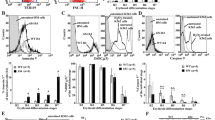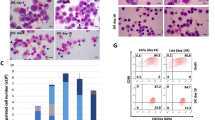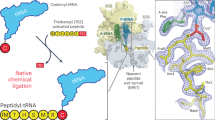Abstract
β-THALASSAEMIA is a hereditary anaemia, characterized by a selective decrease in the synthesis of normal β-globin chains1. It is not known, however, whether the defect in cells of patients with β-thalassaemia results from a deficiency in the amount of messenger RNA (mRNA) for β-globin chains or a defect at the level of protein synthesis on the polyribosomes. Previous studies in intact cells indicated that a defect exists at the level of the ribosome–mRNA complex in reticulocytes from patients with thalassaemia2. Subsequent investigations using a cell-free system confirmed these findings and demonstrated that the ribosomes had a normal capacity to respond to the addition of a synthetic messenger, poly U3. Recent experiments by Clegg and his co-workers demonstrated that the synthetic time for a single β chain is similar in thalassaemic and non-thalassaemic cells4. Taken together, these findings suggest that the defect in β chain synthesis which characterizes thalassaemia arises from either a diminution in the amount of mRNA or an abnormality in the initiation of β chains in these cells. The present studies were designed to investigate more closely some of the events concerned with the initiation of synthesis of polypeptide chains by the ribosome–mRNA complex in red cells from thalassaemic and non-thalassaemic patients.
This is a preview of subscription content, access via your institution
Access options
Subscribe to this journal
Receive 51 print issues and online access
$199.00 per year
only $3.90 per issue
Buy this article
- Purchase on Springer Link
- Instant access to full article PDF
Prices may be subject to local taxes which are calculated during checkout
Similar content being viewed by others
References
Weatherall, D. J., The Thalassaemia Syndromes (Blackwell, Oxford, 1965).
Burka, E., and Marks, P. A., Nature, 199, 706 (1963).
Bank, A., and Marks, P. A., J. Clin. Invest., 45, 330 (1966).
Clegg, J. B., Weatherall, D. J., Na-Nakorn, S., and Wasi, P., Nature, 220, 664 (1968).
Fuhr, J. E., London, I. M., and Grayzel, A. I., Proc. US Nat. Acad. Sci., 63, 129 (1969).
Nomura, M., and Lowry, C., Proc. US Nat. Acad. Sci., 58, 946 (1967).
Bishop, J., Biochim. Biophys. Acta, 119, 130 (1966).
Author information
Authors and Affiliations
Rights and permissions
About this article
Cite this article
FUHR, J., NATTA, C., MARKS, P. et al. Protein Synthesis in Cell-free Systems from Reticulocytes of Thalassaemic Patients. Nature 224, 1305–1307 (1969). https://doi.org/10.1038/2241305a0
Received:
Revised:
Issue Date:
DOI: https://doi.org/10.1038/2241305a0
This article is cited by
Comments
By submitting a comment you agree to abide by our Terms and Community Guidelines. If you find something abusive or that does not comply with our terms or guidelines please flag it as inappropriate.



